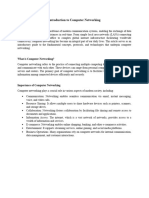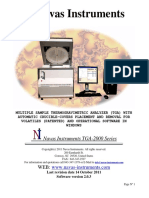Networking Fundamentals
Uploaded by
aniketgedam994Networking Fundamentals
Uploaded by
aniketgedam994Networking Fundamentals: A Comprehensive Guide
Networking fundamentals are the foundation of modern communication, enabling
devices to connect, share resources, and exchange information efficiently. Below is
a detailed explanation of networking essentials.
1. What is Networking?
Networking is the practice of linking multiple computing devices (e.g., computers,
servers, smartphones) to share resources and communicate. These connections allow
data to flow between devices efficiently and are integral to both local setups
(offices, homes) and large-scale systems (internet).
2. Types of Networks
Local Area Network (LAN):
Covers a small area like an office or home.
High-speed connections using Ethernet cables or Wi-Fi.
Wide Area Network (WAN):
Spans vast geographical regions (e.g., the internet).
Connects multiple LANs through routers and telecommunication links.
Metropolitan Area Network (MAN):
Serves a city or large campus.
Often owned and operated by governments or large organizations.
Personal Area Network (PAN):
Connects devices within a personal range, such as Bluetooth-enabled devices.
3. Networking Components
Devices:
Router: Directs data packets between networks.
Switch: Connects devices within the same network.
Modem: Converts digital signals for transmission over traditional phone or cable
lines.
Media:
Wired Connections: Ethernet cables, fiber optics.
Wireless Connections: Wi-Fi, cellular networks, satellite communication.
Protocols:
Define how data is formatted and transmitted.
Common examples: TCP/IP, HTTP, FTP.
4. Networking Protocols
Transmission Control Protocol/Internet Protocol (TCP/IP):
The backbone of the internet, ensuring reliable communication.
HyperText Transfer Protocol (HTTP/HTTPS):
Used for transferring web pages. HTTPS adds encryption for security.
File Transfer Protocol (FTP):
Facilitates file sharing between computers over a network.
Simple Mail Transfer Protocol (SMTP):
Handles the sending of emails.
5. IP Addressing
IPv4 (Internet Protocol version 4):
32-bit addressing scheme (e.g., 192.168.1.1).
Supports approximately 4.3 billion unique addresses.
IPv6 (Internet Protocol version 6):
128-bit addressing scheme for a larger pool of addresses.
Solves the limitations of IPv4.
6. Network Security
Firewalls: Block unauthorized access to networks.
Encryption: Protects data during transmission.
Authentication: Verifies user identities (e.g., passwords, biometrics).
Virtual Private Networks (VPNs): Securely connect remote users to networks.
7. Key Networking Concepts
Bandwidth:
The maximum amount of data that can be transmitted over a network.
Latency:
Delay in data transmission. Lower latency is essential for real-time applications.
Packet Switching:
Divides data into packets for efficient transmission.
Subnets:
Smaller networks within a larger network for better management.
8. Emerging Trends in Networking
5G Technology:
High-speed mobile networks with low latency.
Software-Defined Networking (SDN):
Centralized control of network resources for flexibility.
Internet of Things (IoT):
Expanding connectivity to everyday devices like smart appliances.
Edge Computing:
Processing data closer to the source to reduce latency.
9. Careers in Networking
Networking professionals are in high demand. Key roles include:
Network Engineer: Designs and implements network systems.
Network Administrator: Manages daily network operations.
Cybersecurity Specialist: Protects networks from threats.
Cloud Architect: Designs cloud-based networking solutions.
This overview provides a strong foundation in networking concepts. Let me know if
you'd like to dive deeper into any specific area!
You might also like
- Common User Passenger Processing Systems (CUPPS) PDF100% (1)Common User Passenger Processing Systems (CUPPS) PDF43 pages
- Network Fundamentals Training For XYZ Company AssignmentNo ratings yetNetwork Fundamentals Training For XYZ Company Assignment5 pages
- I can definitely help you brainstorm content for a 10No ratings yetI can definitely help you brainstorm content for a 103 pages
- Basic Networking concepts and knowledgesNo ratings yetBasic Networking concepts and knowledges4 pages
- Complete Computer Networks PresentationNo ratings yetComplete Computer Networks Presentation20 pages
- The Evolution and Future of Computer NetworkingNo ratings yetThe Evolution and Future of Computer Networking13 pages
- Course Syllabus CSSN 32 Network Installation and Configuration 2No ratings yetCourse Syllabus CSSN 32 Network Installation and Configuration 231 pages
- ff04a42d-462b-4969-a3f6-507de834a215_1696585997615_Introduction-to-NetworkingNo ratings yetff04a42d-462b-4969-a3f6-507de834a215_1696585997615_Introduction-to-Networking6 pages
- . Networking Fundamentals – Quick Study GuideNo ratings yet. Networking Fundamentals – Quick Study Guide2 pages
- Computer Networking: An introductory guide for complete beginners: Computer Networking, #1From EverandComputer Networking: An introductory guide for complete beginners: Computer Networking, #14.5/5 (2)
- SAMSUNG K4AAG045WB-MCRC x4 DDP 16G B DDR4 R1.0 Oct.16No ratings yetSAMSUNG K4AAG045WB-MCRC x4 DDP 16G B DDR4 R1.0 Oct.1669 pages
- What Are Software Metrics and How Can You Track ThemNo ratings yetWhat Are Software Metrics and How Can You Track Them12 pages
- Sap HCM User Manual Organizational Management1100% (1)Sap HCM User Manual Organizational Management129 pages
- "Password Generating System": Micro-Project Report ON86% (7)"Password Generating System": Micro-Project Report ON11 pages
- Software-Defined Wide Area Network (SD-WAN) : Architecture, Advances and OpportunitiesNo ratings yetSoftware-Defined Wide Area Network (SD-WAN) : Architecture, Advances and Opportunities9 pages
- MultiVue Quick Guide (EPIQ Evolution 5.0 & Affiniti Continuum 3.0) NewpdfNo ratings yetMultiVue Quick Guide (EPIQ Evolution 5.0 & Affiniti Continuum 3.0) Newpdf5 pages
- Timeline of Computer Security Hacker History100% (1)Timeline of Computer Security Hacker History17 pages

























































































